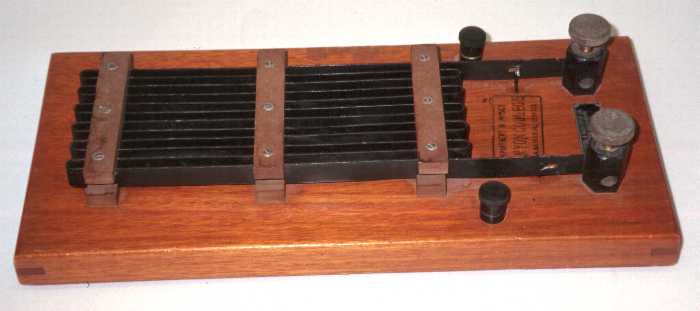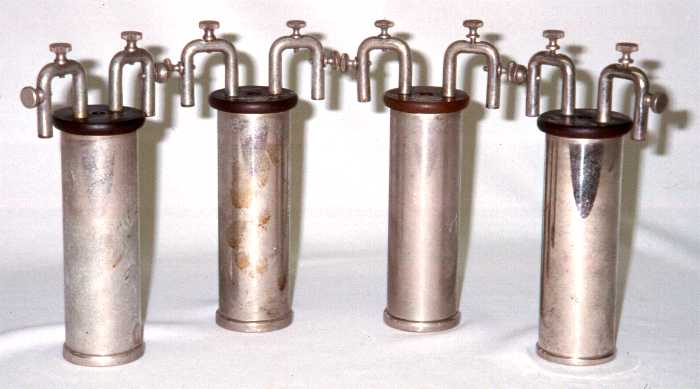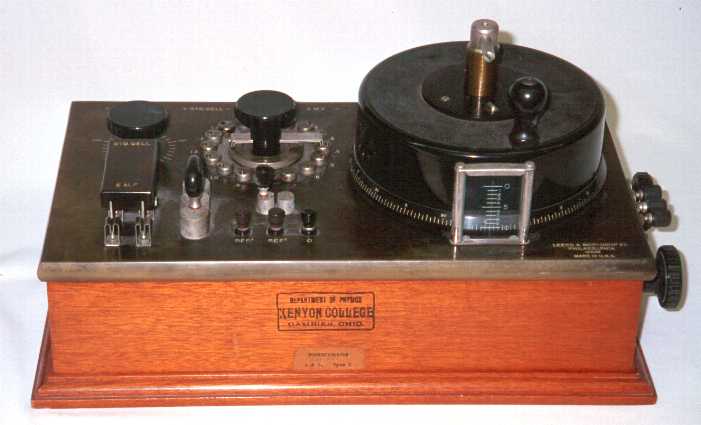In the fall of 1926 Kenyon College in Gambier,
Ohio opened a new science building. It was equipped with the latest apparatus
for undergraduate study of physics. Fortunately, the paperwork for the
purchase of the apparatus for electricity and magnetism from Leeds &
Northrup of Philadelphia has been preserved, along with a good deal of the
apparatus. We now know a good deal of how experimental physics was taught
three quarters of a century ago.
Leeds and Northrup was established in 1903 when Edwin Northrup joined the Morris E. Leeds Company. Presumably the serial numbers of apparatus started at 1; by the late twenties the numbers were in the 110,000 to 120,000 range.
A. Resistance Measurements. Information about the resistances below comes from "Apparatus for Electrical Resistance Measurements", Leeds & Northrup Catalog 40 from 1927.
Standard resistors for large currents must allow any joule heat that is developed to be removed rapidly by convection and radiation. The 0.1 Ohm standard below is rated at 15 Amperes maximum current, and has a stated accuracy of four parts in ten thousand. It cost $55.00.

Pictured below are four Bureau of Standards resistance standards having values of 1, 10, 100 and 1000 ohms. These are of the standard four-terminal construction, with the heavy outer current terminals connected into the circuit and the lighter, inner terminals used to measure the potential drop. The resistance coils are mounted in oil in hermetically-sealed metal cases. The listed accuracy is one part in ten thousand for low power dissipation. These standards cost $20.00 each.

B. Inductance Measurements. The quotes are from "Apparatus for Capacitance, Inductance and Magnetic Measurements", Catalog 10, 1927.
C. Capacitance Measurements.
D. Current Measurements.
E. Voltage Measurements. My primary reference is "Leeds & Northrup Type K Potentiometer", catalogue No. 70, 1922.
The big Type-K Potentiometer, model 7551, is the centerpiece of the Leeds & Northrup measurement system. At $275.00, this was the most expensive piece of apparatus in the department. Like most of the larger pieces of L&N apparatus, this came with a mahogany box that fitted over the top to keep the working portions clean. The top is made of hard rubber; since the top was protected from the atmosphere, the top has not turned reddish brown, as is the case with unprotected instruments such as the capacitance box above. The original design goes back to the earliest days of the company. The last time that this piece of apparatus was used was the fall of 1968, when I used it in a series of measurements of thermoelectric power. The large number of significant figures made it ideal for such work.
The use of the letter "K" is in homage to Friedrich Kohlrausch, one of the inventors of the potentiometer. Here is a link to other Potentiometers.

Leeds and Northrup was established in 1903 when Edwin Northrup joined the Morris E. Leeds Company. Presumably the serial numbers of apparatus started at 1; by the late twenties the numbers were in the 110,000 to 120,000 range.
A. Resistance Measurements. Information about the resistances below comes from "Apparatus for Electrical Resistance Measurements", Leeds & Northrup Catalog 40 from 1927.
| This model 4246 100,000 ohm resistance box is not in the 1927 catalogue. However, the 1911 catalogue No. 44 lists it at $50. By 1926 the price had risen to $90. |
| This Small, Enclosed-Dial Resistance Box is model no. 4773, and cost $33.00. Even though these are working instruments and not standards, the coils are good to one part in a thousand. Each decade uses five resistors, one of one unit value, and four of two units value. They are wound non-inductively so that they can be used in AC bridges and circuits. The top plate is made of hard rubber. This was originally black, but oxidation over the years has turned it reddish. The box is made of mahogany, with mitered and splined corners. |
Standard resistors for large currents must allow any joule heat that is developed to be removed rapidly by convection and radiation. The 0.1 Ohm standard below is rated at 15 Amperes maximum current, and has a stated accuracy of four parts in ten thousand. It cost $55.00.
Pictured below are four Bureau of Standards resistance standards having values of 1, 10, 100 and 1000 ohms. These are of the standard four-terminal construction, with the heavy outer current terminals connected into the circuit and the lighter, inner terminals used to measure the potential drop. The resistance coils are mounted in oil in hermetically-sealed metal cases. The listed accuracy is one part in ten thousand for low power dissipation. These standards cost $20.00 each.
| Leeds & Northrop made these
working resistances that are of the same construction as the coils in the
three-dial box above. Two current and two potential leads make these coils
useful for measuring currents via the four-terminal method. The spacing
of the projecting lugs allowed them to be plugged into the 1-meter student
slide wire bridge. These 4205 and 4206 coils have resistances of 1 and 10 Ohms respectively. The resistance values are good to one part in 1000. |
The Kohlrausch Slide Wire, no. 4258, cost $100.00 in 1926. It has "end coils that provide a very long slide wire in compact form. An accurate index permits reading to one part in 10,000 of the resistance of the slide wire, or, with the end coils, to one part in 100,000 of the resistance of the slide wire and end coils. The wire is mounted on a bakelite drum mounted on a polished hard rubber plate. A bakelite hood carrying the contact slider protects the wire from dust, etc." The instrument was used for making up Wheatstone bridges and potentiometers. |
B. Inductance Measurements. The quotes are from "Apparatus for Capacitance, Inductance and Magnetic Measurements", Catalog 10, 1927.
| "The fixed standards of inductance
... offer a distinct advantage over those available previously, in that
they are wound in toroidal form, This makes them practically immune from
stray field errors and prevents their setting up external fields which might
affect all other apparatus. In order to make these standards useful for measurements
at 1000 cycles, as well as for measurements at the lower frequencies, the
windings are made up of wire having such a small cross-section that there
is no appreciable increase in resistance when used at 1000 cycles. The
approximate time constants (ratio of inductance to resistance) are 0.001
sec and 0.005 for the self and mutual inductances respectively. Each standard
of inductance is mounted in a substantial, ventilated mahogany case with
bakelite top plate." This 10 millihenry standard of self-inductance is model 1532, and has an accuracy of 0.25%. It cost $30.00. |
| The Brooks Inductometer: "This instrument
was designed by H.B. Brooks and F.C. Weaver, of the Bureau of Standards...
It is applicable to problems in which it is necessary to vary the self inductance
of a circuit or the mutual inductance between two circuits while keeping
the resistance constant.. The inductometer has six link-shaped coils, four fixed coils mounted in pairs in two outer fixed plates, and two movable coils mounted on an inner disk... The scale reads self-inductance with all of the coils in series. For use as a mutual inductometer the fixed and movable coils are used as primary and secondary." The Kenyon instrument is model 1520-b, which has a range of 12 to 100 millihenrys. It cost $150.00. Other models had 1.5 to 12 mh and 10 to 800 mh ranges. |
C. Capacitance Measurements.
| The model 1058 Standard Mica Condenser
at the right cost $65. "The No. 1058 Standard Condenser provides a total capacitance of 1 microfarad, subdivided into five sections. By means of switches the sections may be connected in various series and multiple [parallel] combinations. The use of knife switches instead of plugs... [means that] the metal surfaces on the top plate have been reduced in size, and have been more widely separated, which reduces the error due to stray capacitance between these metal parts, ,,," The accuracy was 0.25%. |
D. Current Measurements.
| The Type P reflecting galvanometer
at the left is model 2239-a, and has a sensitivity of 0.014 microampere per
millimeter at one meter. That is, when used with a scale one meter distant,
a current of 0.014 microampere would move the image 1 mm to the side. Leeds & Northrup made a series of Type P instruments with different coil resistances and configurations. The long, narrow coil was used for current measurements, and the sensitivity ranged from 0.014 to 0.0002 microampere. The corresponding prices were in the $25 to $45 range (for the most sensitive model. Instruments with wide coils (having a large moment of inertia) were called ballistic galvanometers and were used to measure charge. The 1926 Kenyon purchase also included spare upper suspensions (narrow strips of 14K gold) and spare lower suspensions (helices made of gold). A repair kit of 6 upper and 3 lower suspensions, 3 suspension terminals, two pairs of tweezers and a jeweler's screwdriver was $7, and several of these have survived, at least in part. |
The model 2166 Ayerton Universal Shunt at the right cost $70.00 in 1926. "Usually the sensitivity of modern galvanometers is ample to permit shunting to adjust the sensitivity and to produce critical damping. It is a great convenience to work with a critically-damped instrument, ... " Without damping the coil oscillates back and forth for a long time before settling into the equilibrium position. |
| The no. 2350A Vibration Galvanometer at the left cost $150 in 1926. It was designed for the detection of small alternating current signals, and would produce a deflection of 1 mm on a scale 1 m distance with a current of 0.025 microamperes. The original purchase included a lamp and scale for making observations. The galvanometer was designed to act as a null detector for inductance and impedance bridges, and would respond to frequencies between 50 and 80 Hz, while giving the best response at 60 Hz. The instrument was considerably more sensitive than the telephone receiver customarily employed with such bridges at these low frequencies. |
E. Voltage Measurements. My primary reference is "Leeds & Northrup Type K Potentiometer", catalogue No. 70, 1922.
The big Type-K Potentiometer, model 7551, is the centerpiece of the Leeds & Northrup measurement system. At $275.00, this was the most expensive piece of apparatus in the department. Like most of the larger pieces of L&N apparatus, this came with a mahogany box that fitted over the top to keep the working portions clean. The top is made of hard rubber; since the top was protected from the atmosphere, the top has not turned reddish brown, as is the case with unprotected instruments such as the capacitance box above. The original design goes back to the earliest days of the company. The last time that this piece of apparatus was used was the fall of 1968, when I used it in a series of measurements of thermoelectric power. The large number of significant figures made it ideal for such work.
The use of the letter "K" is in homage to Friedrich Kohlrausch, one of the inventors of the potentiometer. Here is a link to other Potentiometers.
The Standard Cell offered by Leeds & Northrup in the mid-1920s was made by the Weston Electrical Instrument Co. Edward Weston invented this type of standard cell, so the use of one made by the company that he founded was fitting. However, most of the standard cells after this time were made by Eppley. This cell cost $25.00 in 1926. |